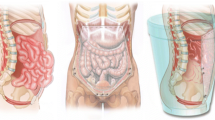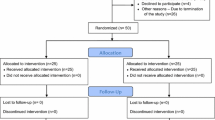Abstract
Background
Abdominal wall reconstruction, especially when fascial defects occur in the flank region, is a field of high interest given the morbidity of hernias. The flank hernia is a rare and challenging entity requiring adequate overlap and secure fixation for a successful repair.
Methods
This is a retrospective case series study including all patients undergoing flank hernia repair using the bony anchoring reinforcement system (BARS) technique from March 2013 through August 2015. An electronic chart review identified seven patients with flank hernias that underwent the BARS procedure.
Results
Six of the patients followed-up for a full year with one patient dropping out after returning to exercise and indicating high satisfaction with operative outcome. There was one recurrent hernia 29 months later. There were no surgical site or mesh infections.
Conclusions
The BARS technique is a versatile and efficacious open approach for repairing flank hernias. It allows for a large area of overlap and secure fixation to the bony structures in the pelvis.
Level of Evidence: Level V, therapeutic study




Similar content being viewed by others
References
Akinduro OO, Jones F, Turner J, Cason F, Clark C (2015) Rare case of a strangulated intercostal flank hernia following open nephrectomy: a case report and review of literature. Int J Surg Case Rep 17:143–145
Kim DJ, Park JW (2015) A rare nonincisional lateral abdominal wall hernia. Ann Surg Treat Res 88(2):111–113
Phillips MS, Krpata DM, Blatnik JA, Rosen MJ (2012) Retromuscular preperitoneal repair of flank hernias. J Gastrointest Surg 16(8):1548–1553
Edwards C, Geiger T, Bartow K, et al. (2009) Laparoscopic transperitoneal repair of flank hernias: a retrospective review of 27 patients. Surg Endosc 23(12):2692–2696
Elkwood AI, Borao FJ, Ashinoff RL, et al. (2014) Complex incisional hernias repaired in conjunction with the bony anchoring reinforcement system (BARS) prevents hernia recurrence. Eur J Plast Surg 37(8):431–436
Pezeshk RA, Pulikkottil BJ, Bailey SH, et al. (2015) An evidence-based model for the successful treatment of flank and lateral abdominal wall hernias. Plast Reconstr Surg 136(2):377–385
Purnell CA, Park E, Turin SY, Dumanian GA (2016) Postoperative flank defects, hernias, and bulges: a reliable method for repair. Plast Reconstr Surg 137(3):994–1001
Bisgaard T, Kehlet H, Bay-Nielsen MB, et al. (2009) Nationwide study of early outcomes after incisional hernia repair. Br J Surg 96(12):1452–1457
Halm JA, Lip H, Schmitz PI, Jeekel J (2009) Incisional hernia after upper abdominal surgery: a randomized controlled trial of midline versus transverse incision. Hernia 13(3):275–280
Kendall SW, Brennan TG, Guillou PG (1991) Suture length to wound length ratio and the integrity of midline and lateral paramedian incisions. Br J Surg. 78(6):705–707
Espositio TJ, Fedorak I (1994) Traumatic lumbar hernia: case report and literature review. J Trauma 37(1):123–126
Heniford BT, Iannitti DA, Gagner M (1997) Laparoscopic inferior and superior lumbar hernia repair. Arch Surg 132(10):1141–1144
Veyrie N, Poghosyan T, Corigliano N, Canard G, Servajean S, Bouillot JL (2013) Lateral incisional hernia repair by the retromuscular approach with polyester standard mesh: topographic considerations and long-term follow-up of 61 consecutive patients. World J Surg 37(3):538–544
Bolkier M, Moskovitz B, Ginesin Y, Levin DR (1991) An operation for incisional lumbar hernia. Eur Urol 20(1):52–53
Cavallaro G, Sadighi A, Miceli M, Burza A, Carbone G, Cavallaro A (2007) Primary lumbar hernia repair: the open approach. Eur Surg Res 39(2):88–92
Author information
Authors and Affiliations
Corresponding author
Ethics declarations
Ethical approval
For this type of retrospective study formal consent is not required.
Conflict of interest
Andrew I. Elkwood, Steven D. Kozusko, Tushar R. Patel, Michael I. Rose, Matthew R. Kaufman, Russell L. Ashinoff, Adam Saad, Steven J. Binenbaum, Frank Borao declare that they have no conflict of interest.
Funding
No grants or funding was received in preparation of this manuscript.
Patient consent
Informed consent was obtained from all individual participants included in this study.
Rights and permissions
About this article
Cite this article
Elkwood, A.I., Kozusko, S.D., Patel, T.R. et al. The bony anchoring reinforcement system (BARS) for flank hernia repair: a versatile technique. Eur J Plast Surg 40, 315–322 (2017). https://doi.org/10.1007/s00238-016-1272-9
Received:
Accepted:
Published:
Issue Date:
DOI: https://doi.org/10.1007/s00238-016-1272-9




